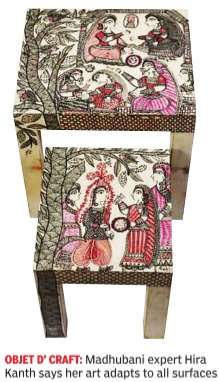Sanjhi
This is a collection of articles archived for the excellence of their content. |
In brief
The Times of India, Nov 01 2015

Malini Nair
Learning the craft of business
For over 350 years, the Soni fam ily of Mathura has been snip ping exquisite paper stencils to create rangolis at Krishna tem ples. But now Sanjhi, as the craft is called, and its delicate motifs -kadamb tree, flowers, butterflies, cows and geometric patterns -are finding different uses. They are on lamps, screens, sliding doors, windows, coasters and trays. Ram Soni's work now decorates homes and public spaces in India and abroad. He is currently displaying his work at the Guangdong trade show. At Akshara, the craft and calligraphy exhibition recently held in Mumbai, the Marwari kavad artist Satyanarayan Sutar gave an unconventional twist to the brightly coloured story boxes of Rajasthan. He crafted a modern cabinet, using traditional kavad colours and lines to paint the story of a villager in a city . “A customer walked up and simply asked me to pack it -no questions about the price. It cost Rs 20,000, five times what I get for a traditional kavad,“ he says.
Sutar and Soni are the new generation of entrepreneurial crafstmen who are adapting themselves to the needs of the market. Most traditional crafts are deeply rooted to the culture that nurtures them -they are celebratory, religious, and ritualistic in nature.What the market-savvy craftsperson is now doing is giving an innovative and utilitarian spin to his art.
Take the example of Hira Kanth, a Madhubani artist who comes from the family of the famous Mahasundari Devi.This wall art, traditionally a domestic ritual, relates mostly to rites of passage, especially marriage. Artists like Hira Kanth are now keenly attuned to what the craft market seeks. “I can do Madhubani work on saris, boxes, trays, walls, in fact on any medium that is demanded of me from clay to cloth,“ she says.
For Akshara, Hira Kanth painted steel trunks with totally unconventional motifs -the buildings, homes and monuments of Delhi. “There is a lot of demand for my work and I also run my own business, I market my own craft. I don't wait for agents and middlemen to do that,“ she says.